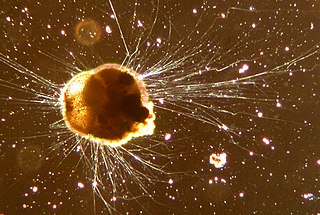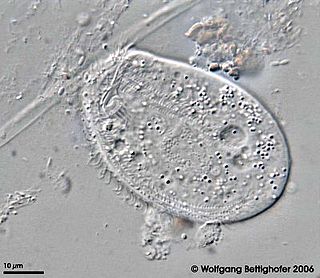Related Research Articles

In cell biology a centriole is a cylindrical organelle composed mainly of a protein called tubulin. Centrioles are found in most eukaryotic cells. A bound pair of centrioles, surrounded by a highly ordered mass of dense material, called the pericentriolar material (PCM), makes up a structure called a centrosome.

The Sipuncula or Sipunculida is a group containing about 162 species of bilaterally symmetrical, unsegmented marine worms. The name Sipuncula is from the genus name Sipunculus, and comes from the Latin siphunculus meaning a "small tube". Sipuncula seems to be closely related to Myzostomida, and Annelida.

Tetrahymena, a unicellular eukaryote, is a genus of free-living ciliates that can also switch from commensalistic to pathogenic modes of survival. They are common in freshwater ponds. Tetrahymena species used as model organisms in biomedical research are T. thermophila and T. pyriformis.

Paramecium is a genus of unicellular ciliates, commonly studied as a representative of the ciliate group. Paramecia are widespread in freshwater, brackish, and marine environments and are often very abundant in stagnant basins and ponds. Because some species are readily cultivated and easily induced to conjugate and divide, it has been widely used in classrooms and laboratories to study biological processes. Its usefulness as a model organism has caused one ciliate researcher to characterize it as the "white rat" of the phylum Ciliophora.

Epithelium is one of the four basic types of animal tissue, along with connective tissue, muscle tissue and nervous tissue. It is a thin, continuous, protective layer of cells. Epithelial tissues line the outer surfaces of organs and blood vessels throughout the body, as well as the inner surfaces of cavities in many internal organs. An example is the epidermis, the outermost layer of the skin.

The bronchioles or bronchioli are the smaller branches of the bronchial airways in the respiratory tract. They include the terminal bronchioles, and finally the respiratory bronchioles that mark the start of the respiratory zone delivering air to the gas exchanging units of the alveoli. The bronchioles no longer contain the cartilage, that is found in the bronchi, or glands in their submucosa.

Micropaleontology is the branch of paleontology (palaeontology) that studies microfossils, or fossils that require the use of a microscope to see the organism, its morphology and its characteristic details.

Foraminifera are single-celled organisms, members of a phylum or class of amoeboid protists characterized by streaming granular ectoplasm for catching food and other uses; and commonly an external shell of diverse forms and materials. Tests of chitin are believed to be the most primitive type. Most foraminifera are marine, the majority of which live on or within the seafloor sediment, while a smaller number float in the water column at various depths. Fewer are known from freshwater or brackish conditions, and some very few (nonaquatic) soil species have been identified through molecular analysis of small subunit ribosomal DNA.

Immunoglobulin A is an antibody that plays a crucial role in the immune function of mucous membranes. The amount of IgA produced in association with mucosal membranes is greater than all other types of antibody combined. In absolute terms, between three and five grams are secreted into the intestinal lumen each day. This represents up to 15% of total immunoglobulins produced throughout the body.
Secretion is the movement of material from one point to another, such as a secreted chemical substance from a cell or gland. In contrast, excretion, is the removal of certain substances or waste products from a cell or organism. The classical mechanism of cell secretion is via secretory portals at the cell plasma membrane called porosomes. Porosomes are permanent cup-shaped lipoprotein structure at the cell plasma membrane, where secretory vesicles transiently dock and fuse to release intra-vesicular contents from the cell.
Club cells, also known as bronchiolar exocrine cells, and formerly known as Clara cells, are low columnar/cuboidal cells with short microvilli, found in the small airways (bronchioles) of the lungs.

Emiliania huxleyi is a species of coccolithophore found in almost all ocean ecosystems from the equator to sub-polar regions, and from nutrient rich upwelling zones to nutrient poor oligotrophic waters. It is one of thousands of different photosynthetic plankton that freely drift in the euphotic zone of the ocean, forming the basis of virtually all marine food webs. It is studied for the extensive blooms it forms in nutrient-depleted waters after the reformation of the summer thermocline. Like other coccolithophores, E. huxleyi is a single-celled phytoplankton covered with uniquely ornamented calcite disks called coccoliths. Individual coccoliths are abundant in marine sediments although complete coccospheres are more unusual. In the case of E. huxleyi, not only the shell, but also the soft part of the organism may be recorded in sediments. It produces a group of chemical compounds that are very resistant to decomposition. These chemical compounds, known as alkenones, can be found in marine sediments long after other soft parts of the organisms have decomposed. Alkenones are most commonly used by earth scientists as a means to estimate past sea surface temperatures.

The Colorado River toad, also known as the Sonoran Desert toad, is found in northern Mexico and the southwestern United States. Its toxin, as an exudate of glands within the skin, contains 5-MeO-DMT and bufotenin.

The uropygial gland, informally known as the preen gland or the oil gland, is a bilobed sebaceous gland possessed by the majority of birds. It is located dorsally at the base of the tail and is greatly variable in both shape and size. In some species, the opening of the gland has a small tuft of feathers to provide a wick for the preen oil. It is a holocrine gland enclosed in a connective tissue capsule made up of glandular acini that deposit their oil secretion into a common collector tube ending in a variable number of pores (openings), most usually two. Each lobe has a central cavity that collects the secretion from tubules arranged radially around the cavity. The gland secretion is conveyed to the surface via ducts that, in most species, open at the top of a papilla.

Respiratory epithelium, or airway epithelium, is a type of ciliated columnar epithelium found lining most of the respiratory tract as respiratory mucosa, where it serves to moisten and protect the airways. It is not present in the vocal cords of the larynx, or the oropharynx and laryngopharynx, where instead the epithelium is stratified squamous. It also functions as a barrier to potential pathogens and foreign particles, preventing infection and tissue injury by the secretion of mucus and the action of mucociliary clearance.

Protozoa is an informal term for a group of single-celled eukaryotes, either free-living or parasitic, which feed on organic matter such as other microorganisms or organic tissues and debris. Historically, protozoans were regarded as "one-celled animals", because they often possess animal-like behaviours, such as motility and predation, and lack a cell wall, as found in plants and many algae. Although the traditional practice of grouping protozoa with animals is no longer considered valid, the term continues to be used in a loose way to describe single-celled protists that feed by heterotrophy. Some examples of protozoa are Amoeba, Paramecium, Euglena and Trypanosoma.

Laminin subunit gamma-3 also known as LAMC3 is a protein that in humans is encoded by the LAMC3 gene.

The ciliates are a group of protozoans characterized by the presence of hair-like organelles called cilia, which are identical in structure to eukaryotic flagella, but are in general shorter and present in much larger numbers, with a different undulating pattern than flagella. Cilia occur in all members of the group and are variously used in swimming, crawling, attachment, feeding, and sensation.

Chilodonella uncinata is a single-celled organism of the ciliate class of alveoles. As a ciliate, C. uncinata has cilia covering its body and a dual nuclear structure, the micronucleus and macronucleus. Unlike some other ciliates, C. uncinata contains millions of minichromosomes in its macronucleus while its micronucleus is estimated to contain 3 chromosomes. Childonella uncinata is the causative agent of Chilodonelloza, a disease that affects the gills and skin of fresh water fish, and may act as a faculitative parasite of mosquito larva.

Climacostomum is a genus of unicellular ciliates, belonging to the class Heterotrichea.
References
- ↑ Hyman, Libbie Henrietta (1940). The invertebrates: Protozoa through Ctenophora. McGraw-Hill.
- ↑ Hedley RH (1963). "Cement and iron in the arenaceious foraminifera". Micropaleontology. The Micropaleontology Project, Inc. 9 (4): 433–441. doi:10.2307/1484505. JSTOR 1484505.
- ↑ Bermudes D, Hinkle G, Margulis L (1994). "Do prokaryotes contain microtubules?". Microbiol. Rev. 58 (3): 387–400. doi:10.1128/MR.58.3.387-400.1994. PMC 372974 . PMID 7968920.
- ↑ Dovgal IV (2002). "Evolution, phylogeny and classification of Suctorea (Ciliophora)" (PDF). Protistology. 2 (4): 194–270. Archived from the original (PDF) on 2005-12-31.